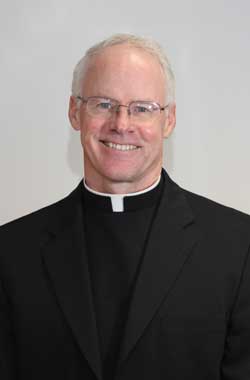Joe: Hey, Pop, I hear the new Pope is the first Pope Francis ever.
Pop: Joe, I was surprised. With so many popular saints named Francis, I thought there would have been one by now.
Tom: Pop, you really struck out. I went on line and learned that there has never been a Pope Joseph or a Pope Thomas. How did you come to name us?
———–

The Bridges, a column about the fictional Bridges family, is written by Father John J. Ames, deputy secretary for the Office for Catechetical Formation for the Archdiocese of Philadelphia.
On March 13, 2013, the Catholic Church elected its 266th Pope. People throughout the world gathered in St. Peter’s Square to welcome Jorge Mario Bergoglio from Argentina as the new bishop of Rome. Since the new Pope is a member of the Society of Jesus (Jesuits), I assumed that he chose the name, Francis, in honor of St. Francis Xavier, an original member of the Society. I was surprised when he made it clear that he chose the name in honor of St. Francis of Assisi. He really could not go wrong with either St. Francis.
Francis Xavier (1506-1552, Feast: December 3) met Ignatius of Loyola at the University of Paris. The 24-year-old Francis was a young teacher of philosophy who had a highly promising academic career and a life of prestige and honor before him. Ignatius saw something special in Francis. He kept asking Francis a question that Jesus asked in the Gospel. “What profit would there be for one to gain the whole world and forfeit his life?” (Mt. 16:26).
Francis did not heed these words at once. Ignatius’ persistence finally convinced Francis to go on a retreat. Following the retreat, Francis joined a small community who vowed poverty, chastity and a special promise of obedience to the pope. This group of seven would initially be known as the “Company” and later grow to become the Society of Jesus, the largest community of priests in the world.
The Pope had requested that two of this community travel to India and evangelize the people. When one of those who was supposed to travel became ill, Ignatius designated Francis to go in his place. He was ordained priest and sailed to the East Indies, landing on the west coast of India. Francis traveled through the islands of Malaysia, then up to Japan. He learned enough Japanese to preach to simple folk, to instruct and to baptize, and to establish missions. From Japan he had dreams of going to China, but this plan was never realized. Before reaching the mainland he became sick. He was removed from the ship and left on the sands of the shore of the island of Sancian, where he died.
Wherever he went, he lived with the poorest people, sharing their food and rough accommodations. He spent countless hours ministering to the sick and the poor, particularly to lepers. Very often he had no time to sleep and little time to pray. However, as we know from his letters, he was filled always with joy.
Francis of Assisi (1181-1226; Feast: October 4) astounded and inspired the Church by taking the Gospel literally. As a youth he enjoyed a comfortable lifestyle and a social life filled with excess. Serious illness brought the young Francis to question his priorities. In his prayer, he kept hearing, “Francis, repair my Church!” At first, Francis thought that Jesus was referring to the crumbling church building in which he was praying. In time, Francis realized that Jesus was speaking to him about the entire Church, which was filled with scandal.
Francis gave away his worldly possessions and embraced a life of poverty. He devoted his life to prayer and penance. He desired to be poor so that he might be more like Christ and depend ever more on God. He loved nature because it was another sign of the beauty of God. At his core, he wanted to live as Jesus taught.
He began to preach and attracted numerous followers. He eventually went to Rome and received approval to found a new religious community, the Order of Friars Minor. Members of the community lived a simple lifestyle with an emphasis on poverty and preaching the Gospel.
Francis did endure much suffering during his life. He encountered opposition from those outside and inside his community who questioned the radical ideal of poverty that he demanded. He received the stigmata (the marks of the nails and the lance wound that Christ suffered) in his own body. Francis’ health declined and he became blind. He died on October 4, 1226 at the age of 45.
Do you have a favorite St. Francis? Don’t forget St. Francis DeSales.



Share this story